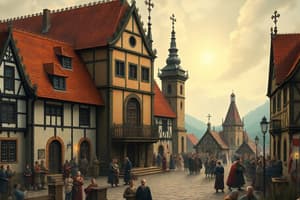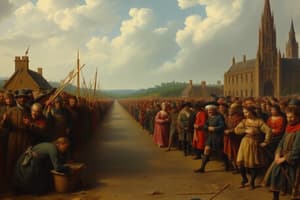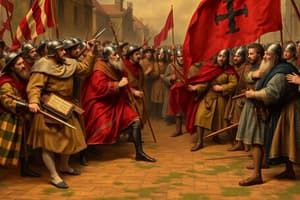Podcast
Questions and Answers
¿Cuáles fueron algunos de los motivos que ocasionaron los conflictos en Europa durante el siglo XVII?
¿Cuáles fueron algunos de los motivos que ocasionaron los conflictos en Europa durante el siglo XVII?
- La lucha entre clases sociales
- El deseo de las monarquías de extender sus fronteras (correct)
- La invención de nuevas tecnologías bélicas
- Las alianzas militares entre países
¿Qué caracterizó el inicio de la Guerra de los Treinta Años?
¿Qué caracterizó el inicio de la Guerra de los Treinta Años?
- Fue una revolución campesina
- Fue un conflicto entre reyes y nobles
- Fue una disputa territorial entre España y Francia
- Fue un enfrentamiento religioso entre católicos y protestantes (correct)
¿Qué papel jugó Fernando II de Habsburgo en la Guerra de los Treinta Años?
¿Qué papel jugó Fernando II de Habsburgo en la Guerra de los Treinta Años?
- Abdicó de su poder ante los nobles
- Impidió que los protestantes eligieran su religión (correct)
- Intentó expandir su territorio
- Promovió la paz entre los estados europeos
¿Qué ocurrió en Alemania como resultado de la Guerra de los Treinta Años?
¿Qué ocurrió en Alemania como resultado de la Guerra de los Treinta Años?
¿Qué consecuencia tuvo la Paz de Westfalia para los Habsburgo?
¿Qué consecuencia tuvo la Paz de Westfalia para los Habsburgo?
¿Qué derecho se confirmó para los principados en el Tratado de Paz de Westfalia?
¿Qué derecho se confirmó para los principados en el Tratado de Paz de Westfalia?
¿Qué efecto tuvo la Guerra de los Treinta Años en las ciudades alemanas?
¿Qué efecto tuvo la Guerra de los Treinta Años en las ciudades alemanas?
¿Qué otro problema se extendió en el continente europeo durante la Guerra de los Treinta Años?
¿Qué otro problema se extendió en el continente europeo durante la Guerra de los Treinta Años?
¿Qué tipo de apoyo económico recibieron las compañías comerciales creadas por neerlandeses, ingleses y franceses?
¿Qué tipo de apoyo económico recibieron las compañías comerciales creadas por neerlandeses, ingleses y franceses?
¿Cuál fue una de las principales diferencias entre el comercio en el mar Báltico y el comercio triangular?
¿Cuál fue una de las principales diferencias entre el comercio en el mar Báltico y el comercio triangular?
¿Qué productos eran típicamente vendidos en las colonias americanas a cambio de personas esclavizadas?
¿Qué productos eran típicamente vendidos en las colonias americanas a cambio de personas esclavizadas?
¿Cuál fue una de las medidas proteccionistas implementadas por Jean-Baptiste Colbert en Francia?
¿Cuál fue una de las medidas proteccionistas implementadas por Jean-Baptiste Colbert en Francia?
¿Cuál era uno de los principales motores de la economía inglesa durante este período?
¿Cuál era uno de los principales motores de la economía inglesa durante este período?
¿Cuál fue una consecuencia de la incapacidad de España para retener el oro y la plata en sus fronteras?
¿Cuál fue una consecuencia de la incapacidad de España para retener el oro y la plata en sus fronteras?
¿Qué instrucciones dictó el equipo de Colbert para mejorar la industria en Francia?
¿Qué instrucciones dictó el equipo de Colbert para mejorar la industria en Francia?
¿Qué tipo de productos eran utilizados en Europa para confeccionar telas destinadas al comercio?
¿Qué tipo de productos eran utilizados en Europa para confeccionar telas destinadas al comercio?
¿Qué país reconoció la independencia de las Provincias Unidas?
¿Qué país reconoció la independencia de las Provincias Unidas?
¿Cuál fue la consecuencia de la muerte del rey Carlos II de España en 1700?
¿Cuál fue la consecuencia de la muerte del rey Carlos II de España en 1700?
¿Qué doctrina defendían las clases dominantes europeas durante el siglo XV?
¿Qué doctrina defendían las clases dominantes europeas durante el siglo XV?
¿Qué territorio pasó a ser dominio de Inglaterra tras la Paz de Utrecht?
¿Qué territorio pasó a ser dominio de Inglaterra tras la Paz de Utrecht?
¿Qué potencia destacó en el comercio internacional durante la expansión económica del siglo XV?
¿Qué potencia destacó en el comercio internacional durante la expansión económica del siglo XV?
¿Qué evento marcó el inicio de la dinastía de los Borbones en España?
¿Qué evento marcó el inicio de la dinastía de los Borbones en España?
¿Qué avance técnico contribuyó a la creación de un auténtico mercado mundial durante el siglo XV?
¿Qué avance técnico contribuyó a la creación de un auténtico mercado mundial durante el siglo XV?
¿Cuál fue una de las principales motivaciones detrás de la competencia entre potencias por dominar las rutas marítimas?
¿Cuál fue una de las principales motivaciones detrás de la competencia entre potencias por dominar las rutas marítimas?
¿Cuál fue una de las principales consecuencias del crecimiento de la población en Europa a partir del siglo XVI?
¿Cuál fue una de las principales consecuencias del crecimiento de la población en Europa a partir del siglo XVI?
¿Qué método de cultivo se combinó con la rotación trienal durante los cambios en el espacio rural?
¿Qué método de cultivo se combinó con la rotación trienal durante los cambios en el espacio rural?
¿Qué sucedió con los campesinos que trabajaban en tierras comunales en el siglo XVI?
¿Qué sucedió con los campesinos que trabajaban en tierras comunales en el siglo XVI?
¿Qué efecto tuvo la abundancia de alimentos en la población europea durante el periodo mencionado?
¿Qué efecto tuvo la abundancia de alimentos en la población europea durante el periodo mencionado?
¿Qué característica del sistema de industria rural a domicilio se destacó en la producción de textiles?
¿Qué característica del sistema de industria rural a domicilio se destacó en la producción de textiles?
¿Qué efecto tuvo la necesidad de producir más productos manufacturados sobre la calidad de estos?
¿Qué efecto tuvo la necesidad de producir más productos manufacturados sobre la calidad de estos?
¿Cuál fue uno de los cambios drásticos en Inglaterra durante este periodo?
¿Cuál fue uno de los cambios drásticos en Inglaterra durante este periodo?
¿Qué permitió a más europeos acceder a bienes antes inaccesibles?
¿Qué permitió a más europeos acceder a bienes antes inaccesibles?
¿Cuál era la percepción acerca de las mujeres en una época patriarcal?
¿Cuál era la percepción acerca de las mujeres en una época patriarcal?
¿Qué libro se volvió popular durante las caza de brujas?
¿Qué libro se volvió popular durante las caza de brujas?
¿Cómo se actuaba usualmente con las acusadas de brujería?
¿Cómo se actuaba usualmente con las acusadas de brujería?
En la sociedad del Antiguo Régimen, ¿qué factor comenzó a tener más relevancia en el estatus social?
En la sociedad del Antiguo Régimen, ¿qué factor comenzó a tener más relevancia en el estatus social?
¿Cómo se percibía la magia en el siglo XVII?
¿Cómo se percibía la magia en el siglo XVII?
¿Qué ocurrió con el poder político de la nobleza con el advenimiento de las monarquías absolutas?
¿Qué ocurrió con el poder político de la nobleza con el advenimiento de las monarquías absolutas?
¿Cuál era una de las penas recomendadas para las acusadas de brujería según El martillo de las brujas?
¿Cuál era una de las penas recomendadas para las acusadas de brujería según El martillo de las brujas?
¿Qué privilegio gozaban los nobles en el Antiguo Régimen?
¿Qué privilegio gozaban los nobles en el Antiguo Régimen?
¿Cuál era la percepción de los habitantes acomodados sobre los marginales?
¿Cuál era la percepción de los habitantes acomodados sobre los marginales?
¿Qué tipo de leyes se establecieron en las ciudades para tratar a los marginales?
¿Qué tipo de leyes se establecieron en las ciudades para tratar a los marginales?
¿Cómo era la vida de los sectores populares en comparación con la de los nobles?
¿Cómo era la vida de los sectores populares en comparación con la de los nobles?
¿Qué rol cumplían algunas instituciones religiosas con respecto a los marginales?
¿Qué rol cumplían algunas instituciones religiosas con respecto a los marginales?
¿Cuál de los siguientes lugares se volvió popular para la socialización entre clases sociales?
¿Cuál de los siguientes lugares se volvió popular para la socialización entre clases sociales?
¿Qué riesgos corrían aquellos que no actuaban de acuerdo a su lugar en la sociedad bajo los gobiernos absolutistas?
¿Qué riesgos corrían aquellos que no actuaban de acuerdo a su lugar en la sociedad bajo los gobiernos absolutistas?
¿Qué aspecto de la vida de los nobles era particularmente notable?
¿Qué aspecto de la vida de los nobles era particularmente notable?
¿Cómo vivían la mayoría de los sectores populares en términos de espacio?
¿Cómo vivían la mayoría de los sectores populares en términos de espacio?
Flashcards
Causes of European Conflicts (17th Century)
Causes of European Conflicts (17th Century)
Monarchies' desire to expand their borders was a key driver of conflicts in Europe during the 17th century.
Thirty Years' War Cause
Thirty Years' War Cause
The Thirty Years' War began as a religious conflict between Catholics and Protestants in Europe.
Fernando II's Role (Thirty Years' War)
Fernando II's Role (Thirty Years' War)
Fernando II of Habsburg opposed Protestant religious choices in the Thirty Years' War.
Thirty Years' War's Impact on Germany
Thirty Years' War's Impact on Germany
Signup and view all the flashcards
Peace of Westphalia & Habsburgs
Peace of Westphalia & Habsburgs
Signup and view all the flashcards
Westphalia Treaty & Principalities
Westphalia Treaty & Principalities
Signup and view all the flashcards
Thirty Years' War's Effect on Cities
Thirty Years' War's Effect on Cities
Signup and view all the flashcards
European Mortality Increase
European Mortality Increase
Signup and view all the flashcards
Private Investment in Dutch, English, French Companies
Private Investment in Dutch, English, French Companies
Signup and view all the flashcards
Baltic vs. Triangular Trade
Baltic vs. Triangular Trade
Signup and view all the flashcards
American Colonial Products Traded for Enslaved People
American Colonial Products Traded for Enslaved People
Signup and view all the flashcards
Colbert's Protectionist Measures
Colbert's Protectionist Measures
Signup and view all the flashcards
English Economic Driver
English Economic Driver
Signup and view all the flashcards
Spanish Inability to Retain Wealth
Spanish Inability to Retain Wealth
Signup and view all the flashcards
Colbert's Industrial Instructions
Colbert's Industrial Instructions
Signup and view all the flashcards
European Textile Material Source
European Textile Material Source
Signup and view all the flashcards
Netherlands Independence Recognition
Netherlands Independence Recognition
Signup and view all the flashcards
Charles II Death's Impact
Charles II Death's Impact
Signup and view all the flashcards
European Ruling Class Doctrine
European Ruling Class Doctrine
Signup and view all the flashcards
Utrecht Treaty & England's Territory
Utrecht Treaty & England's Territory
Signup and view all the flashcards
Important International Trader (1500s)
Important International Trader (1500s)
Signup and view all the flashcards
Bourbon Dynasty Start in Spain
Bourbon Dynasty Start in Spain
Signup and view all the flashcards
Market Expansion Technique
Market Expansion Technique
Signup and view all the flashcards
Maritime Route Competition
Maritime Route Competition
Signup and view all the flashcards
European Population Growth Impact
European Population Growth Impact
Signup and view all the flashcards
Rural Space Changes - Cultivation
Rural Space Changes - Cultivation
Signup and view all the flashcards
Common Land Loss - Campesinos
Common Land Loss - Campesinos
Signup and view all the flashcards
Food Abundance's Impact
Food Abundance's Impact
Signup and view all the flashcards
Rural Home Industry
Rural Home Industry
Signup and view all the flashcards
Industry Production Quality
Industry Production Quality
Signup and view all the flashcards
English Land Changes
English Land Changes
Signup and view all the flashcards
European Economic Access
European Economic Access
Signup and view all the flashcards
Patriarchal Society's View of Women
Patriarchal Society's View of Women
Signup and view all the flashcards
Witch Trials and Popular Literature
Witch Trials and Popular Literature
Signup and view all the flashcards
Witch Hunting Consequences
Witch Hunting Consequences
Signup and view all the flashcards
Social Status and Economic Power
Social Status and Economic Power
Signup and view all the flashcards
Magics' Perception
Magics' Perception
Signup and view all the flashcards
Noble Power Decline
Noble Power Decline
Signup and view all the flashcards
Recommendations for Witches
Recommendations for Witches
Signup and view all the flashcards
Noble Tax Exemptions
Noble Tax Exemptions
Signup and view all the flashcards
Marginalized Perception
Marginalized Perception
Signup and view all the flashcards
Urban Regulations on Marginalized People
Urban Regulations on Marginalized People
Signup and view all the flashcards
Popular Life vs. Noble Life
Popular Life vs. Noble Life
Signup and view all the flashcards
Religious Institutions and Marginals
Religious Institutions and Marginals
Signup and view all the flashcards
Socialization Venue
Socialization Venue
Signup and view all the flashcards
Social Conformity and Risk
Social Conformity and Risk
Signup and view all the flashcards
Noble Lifestyle Emphasis
Noble Lifestyle Emphasis
Signup and view all the flashcards
Popular Housing Conditions
Popular Housing Conditions
Signup and view all the flashcards




